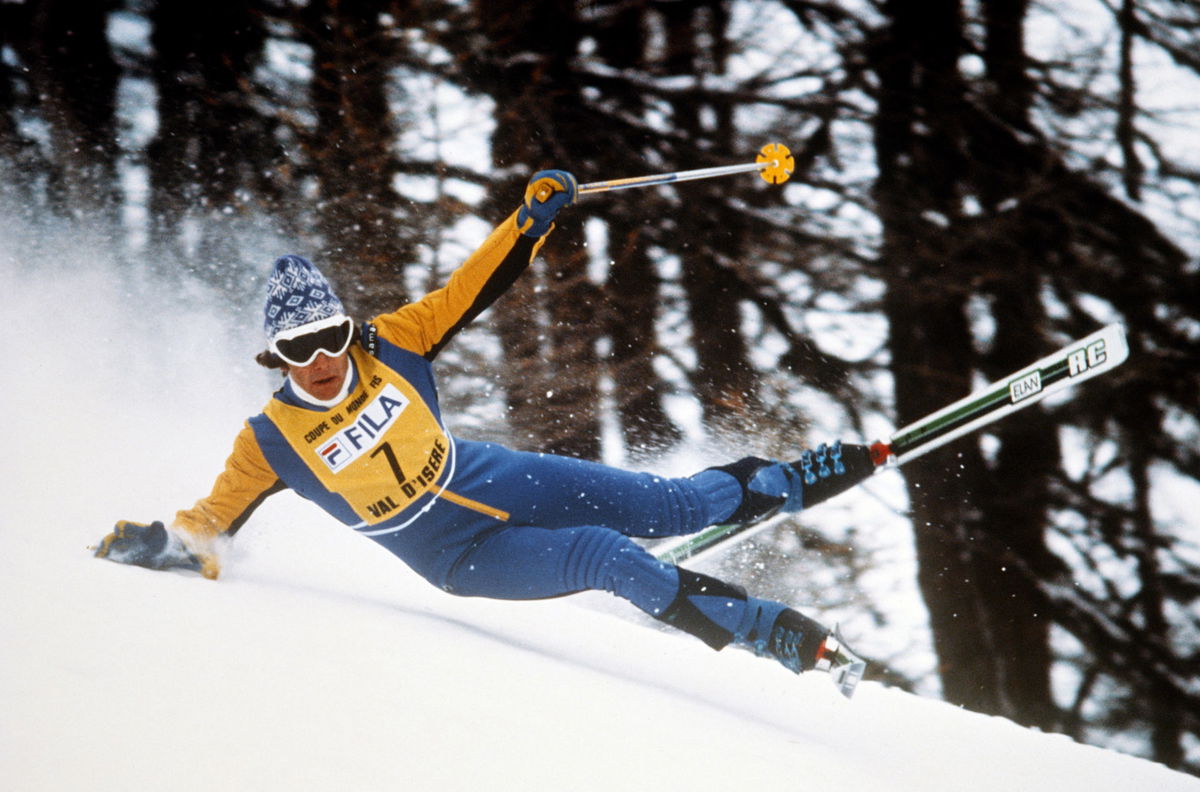
Getty
Ingemar Stenmark of Sweden falls while skiing in the Men’s Slalom event at the International Ski Federation FIS Alpine Skiing World Cup on 8 December 1979 in Val d’Isère, France. (Photo by Getty Images)

Getty
Ingemar Stenmark of Sweden falls while skiing in the Men’s Slalom event at the International Ski Federation FIS Alpine Skiing World Cup on 8 December 1979 in Val d’Isère, France. (Photo by Getty Images)
For Alpine skiing fans around the world, the wait is almost over, as the 2024-25 FIS Ski World Cup kicks off on October 26. With nearly 90 races to look forward to, Sölden, Austria, will host the season opener. While the FIS didn’t reduce the number of events, they introduced significant changes after seeing several athletes suffer injuries and raise concerns.
Watch What’s Trending Now!
Among those who didn’t mince their words was Mikaela Shiffrin. “I absolutely believe that fatigue at this point in the season plays a role in the injuries we have seen lately, including my own.” the Olympian said. So for this year, the FIS is including some tried and tested slopes, eliminating some risky ones and even making changes to certain courses. However, that doesn’t mean the athletes won’t come across challenging slopes throughout the season.
ADVERTISEMENT
Streif, Kitzbühel, Austria: The FIS Ski World Cup’s most iconic slope?
Events: Downhill, Slalom and Super‑G
The Streif is arguably the single most iconic slope in Alpine skiing history. One of the many reasons is the venue’s rich history. The first skiing event on the Streif took place 87 years ago in 1937. Since then, the course has built a reputation as one of the most challenging and fastest slopes in the world. The Streif is incredibly steep with, Mausefalle, the steepest part of the slope featuring 40.4 degrees or 85% maximum gradient.
Top Stories
Greg Biffle’s $4M Worth Prized Possession Still Without a Buyer Leaves NASCAR Fans Heartbroken

LIV Golf Braces for Another Possible Exit in Wake of Brooks Koepka Departure

Sean Payton Announces Retirement Plans as Broncos HC Demands Improvement From Bo Nix & Co. Before Playoffs

Biff Poggi All But Confirms Bryce Underwood’s Michigan Future After Announcing His Own Departure

Roger Federer Draws Criticism from Swiss Government Chief for Tourism Boom in Country

Amanda Balionis Confirms New Relationship Ending Months of Rumors

Besides being steep, skiers can reach mind-boggling speeds of 85-90 mph (140-145 kph) on the fastest sections of this highly technical course. In fact, the Streif remained unconquered by a woman until 2023, when Lindsey Vonn became the first to ski down the legendary slope. Vonn masterfully captured the intense experience, describing what an athlete feels while skiing down the mountain in Austria.
ADVERTISEMENT

Imago
ALPINE SKIING – FIS WC Spindleruv Mlyn SPINDLERUV MLYN,CZECH REPUBLIC,29.JAN.23 – ALPINE SKIING – FIS World Cup, slalom, ladies. Image shows Mikaela Shiffrin USA. PUBLICATIONxNOTxINxAUTxSUIxSWE GEPAxpictures/xManfredxBinder
“I felt like I was jumping over the edge of the world… I don’t think I’ve ever been so nervous before a start in my life,” said Vonn. Yet despite its notorious difficulty, the Streif is also a tried and tested course, which doesn’t present many surprises for season skiers.
ADVERTISEMENT
Lauberhorn, Wengen, Switzerland
Events: Downhill, Slalom and Super‑G
Next on the list is the location known for its iconic downhill races: Lauberhorn in Wengen, Switzerland. What makes Lauberhorn special is that it features the longest downhill course in the FIS Ski World Cup. Stretching 2.78 miles (4.48 km), this iconic course tests the stamina and endurance of even the best skiers in the world.
ADVERTISEMENT
Although it may not be as technical as the Streif, the Lauberhorn course rivals the Austrian slope’s speed. In fact, Lauberhorn is unofficially considered the fastest race in the FIS Ski World Cup. According to RedBull.com, Johan Clarey of France set an unofficial speed record of 100.6 mph (161.9 kph) on the course in January 2013. However, it’s the next contender that truly stands out for its level of difficulty.
Birds of Prey, Beaver Creek, USA
Events: Downhill, Giant Slalom, and Super‑G
ADVERTISEMENT
With a 753 m drop, Birds of Prey live to what it’s named after. Although the course’s steepest section sports a lower maximum gradient of 63%, which is lower than the Streif, its average gradient is higher at 31%, compared to 27% at Kitzbühel. However, the reason they call this course the Birds of Prey is because of the six massive jumps named after different birds of prey.

Getty
ARE, SWEDEN – FEBRUARY 26: (FRANCE OUT) Lindsey Vonn of the USA takes 1st place during the Audi FIS Alpine Ski World Cup Women’s Downhill on February 26, 2011 in Are, Sweden. (Photo by Nisse Schmidt/Agence Zoom/Getty Images)
The six jumps are called the Peregrine, Goshawk, Screech Owl, Golden Eagle, Harrier, and Red Tail. The jumps combined with steep turns on a slope that’s on average even steeper (at least on paper) than the Streif, and you have one of the toughest downhill races of the Ski World Cup.
ADVERTISEMENT
Saslong, Val Gardena, Italy
Events: Downhill and Super-G
For the next challenging downhill course, look no further than Saslong in Val Gardena. While the course may not look super challenging to the untrained eye, numerous bumps and humps along the course make it difficult to navigate. Alpine skiers reach speeds up to 80 mph (130 kph) on the course’s most famous feature, the camel humps.
ADVERTISEMENT
These three humps cause skiers to accelerate rapidly while adding an aerial element. Competitors can fly up to 70 meters in the air when coming off the final hump at the camel humps section of this FIS Ski World Cup course. However, these aren’t the only bumps on the course. What makes the course challenging is the unpredictability of how skiers hit the humps and then land on their two feet. Numerous crashes at the Saslong have prompted the organizers to implement several adjustments to enhance safety on the course.
Bormio, Italy: An underrated Ski World Cup course?
Events: Downhill and Super‑G
ADVERTISEMENT
You may be more familiar with reports of the Cortina d’Ampezzo’s difficulty and notoriously steep Tofana Schuss section. After all, it was this course that derailed Mikaela Shiffrin’s plans to reach the landmark 100 Ski World Cup race victories last season. However, Bormio is also among the most difficult courses in Italy, with a 65% gradient at some of its steepest points.

Getty
MADONNA DI CAMPIGLIO, ITALY – DECEMBER 22: Clement Noel of Team France crashes out during the Audi FIS Alpine Ski World Cup Men’s Slalom on December 22, 2021, in Madonna di Campiglio Italy. (Photo by Alexis Boichard/Agence Zoom/Getty Images)
Bormio also shares the stamina-draining length of Lauberhorn, Wengen. While not quite as long as the course in Switzerland, Borimio takes the title for the second-longest FIS Ski World Cup downhill race. It takes elite skiers nearly 2 minutes to finish the race.
It’s nearly impossible to rank the Ski World Cup course because the organizers chose each slope carefully and every course presents its own set of challenges for skiers to overcome. So these are five of the most difficult races you can look forward to watching in the coming months at the FIS Ski World Cup, in no particular order.
ADVERTISEMENT
ADVERTISEMENT
ADVERTISEMENT

